Unit -1
Fundamentals of statics
Q1)-1 Define force system and classify it
Ans- System of forces:-when two or more forces act on a system or a body simultaneously it is known as a force system or system of force.
Classification of force system
1) Coplanar
2) Non coplanar
Coplanar:-
1) Collinear
2) Concurrent
3) Parallel
4) Non concurrent non parallel
Non coplanar:-
1) Concurrent
2) Parallel
3) Non concurrent non parallel
Coplanar force system:-
If all forces acting on a body are in same plane then force system is known as coplanar force system.
1) Coplanar collinear

When all forces acts on body are in same plane and line of action of all forces acts along same line then system is known as coplanar collinear force system.
Example:-
Forces on rope in tug of war
2) Coplanar concurrent

When all forces acting on body are in same plane and line of action of forces passes through single force then the system is known as coplanar concurrent force system.
Example: - Gusset plate of electric tower
3) Coplanar parallel
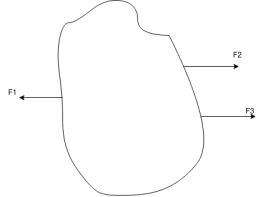
When all forces acting on a body are in same plane at their line of action of forces are parallel to each other then system is known as coplanar parallel force system.
Example: - beam subjected to vertical loading
4) Coplanar non concurrent non parallel
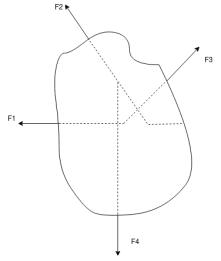
When all forces acting on a body are in same plane but they are neither parallel known concurrent then system is known as coplanar non concurrent non parallel force system.
Example:- forces on ladder resting against wall when person stands on rung which is not at its centre of gravity.
This force system is also known as general system of forces.
Non coplanar force system:-
If forces acting on a body are in different plane then force system is known as non-coplanar force system.
1) Non coplanar concurrent
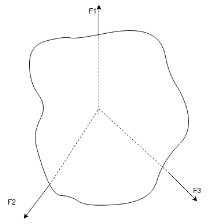
When all forces acting on a body do not lie in same plane but their line of action pass through a single point then force system is known as non-coplanar concurrent force system.
Example: - electric pole supported by guy wire
2) Non coplanar parallel

When all forces acting on a body are parallel to each other but do not lie in same plane then the force system is known as non-coplanar parallel force system.
Example: - Weight of benches in classroom.
3) Non coplanar non concurrent non parallel

When all forces acting on a body do not lie in same plane and neither they are parallel or concurrent then force system is known as known coplanar non concurrent non parallel force system.
Example: - forces acting on moving bus.
Q2)2 Define moment of force and couple
Ans. Movement of a force:-It is turning effect produced by a force on the body. The movement of force is equal to the product of force and perpendicular distance of point about which the movement is required and line of action force.
Mathematically:- moment (m) =p×l
Where, p=force acting on body
l =perpendicular distance between the point about which movement is required and line of action of the force
Unit of moment:-if force is in Newton and distance is in meter then unit of moment is Newton meter (Nm)
Couple:-Two parallel forces equal in magnitude and opposite in direction and separated by a definite distance are set to form a couple. The sum of forces forming couple is zero since they are equal and opposite which means translate your faith of couple is zero but it produces a motion of rotation body on which it act.

Q3)-3 state and explain varignon’s theorem
Ans. Varignon's principle of moments a law of moments:- It states,” the algebraic sum of moments of a system of coplanar forces about a moment centre in the plane is equal to moment of their resultant force about same movement centre.”
Proof:- let R be the resultant of forces  and B the moment centre. Let d,
and B the moment centre. Let d, be the moment and arm ( perpendicular distance of point from the line of action of force) of forces. Respectively from movement centre (point about which movement is considered) B then in this case we have to prove that
be the moment and arm ( perpendicular distance of point from the line of action of force) of forces. Respectively from movement centre (point about which movement is considered) B then in this case we have to prove that

Join AB and considered it as y axis and draw exercise at right angle to it at a as shown in figure 22( b).
Denoting by Q the angle that R makes with x axis and noting that the same angle is formed by perpendicular to R at B with  we can write
we can write



Where
 Component of R in x-direction
Component of R in x-direction
Similarly, if  are component of
are component of  in x-direction then,
in x-direction then,


Add equations 2 and 3
 )
)

From equation 1

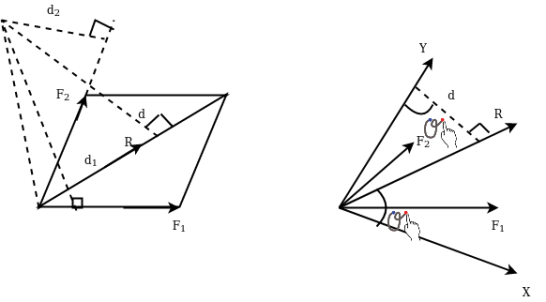
Q4)-4 the resultant of two forces when they act at right angle B 10N and when they act at angle of 60  resultant B 12.16 N . Find magnitude of two forces.
resultant B 12.16 N . Find magnitude of two forces.
Ans. Let  be two forces
be two forces
Condition 1- when they act at right angle




Condition -2 when they act at angle 60 










Put 





Q5)5 The guy wire of electrical pole as shown in fig below makes 60 to horizontal as is carrying a force 60KN . Find horizontal and vertical components of forces.

Ans.-
R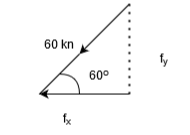 esolution of force f=60KN
esolution of force f=60KN


51.96 KN (downward)
Q6)6 Fig. Shown below showed as particular position of 200mm connecting rod AB and 80mm long tank BC. At this position connecting rod of engine experience a force of 300N on rank pin at B. Find its
- Horizontal and vertical component
- Component along BC and normal to it.
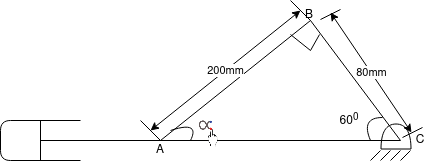
Ans. The force 3000N acts along line AB . Let AB makes angle  with horizontal then
with horizontal then 
Resolution of force f=300N
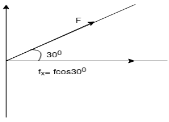

2598.07 N

1500N
Component along and normal to tank
The force makes angle 
Component along tank= 3000 cos90
=0
Component normal to tank= 3000 sin 90
=3000N
Q7)-7 find the moment of force 50 N about A,B,C,D and 0 respectively shown in fig. Below

Ans. moment about A=
Moment about B=
=350N.m (anticlockwise)
Moment about C= 
=450N.m (anticlockwise)
Moment about D=
100 N.m (clockwise)
Q8)8 The system of force acting on bell rank. As shown in fig. Determine the magnitude direction and point of application of resultant.

Ans – 



-2633.01 N
2633.01 (to downward)

2671.19 N
Tan x =

Let point of application of resultant be at a distance x from a along horizontal arm.


Resultant moment is anticlockwise
X=141.195 mm
Q9)9 Determine the resultant of four forces acting on body as shown in fig. Below

Ans. for force 500N


Now



=173.13 N

R=199.91 N

=60
Q10)10 The three like parallel forces 101 N,F and 300N are acting as shown in fig.

If the resultant R=600N and is acting at a distance 45 cm from A then find magnitude of force f and distance of F from A
Ans. 



Squaring on both sides






But FB in the +y direction

According to varignon’s theorem
 (Resultant moment in anticlockwise)
(Resultant moment in anticlockwise)

